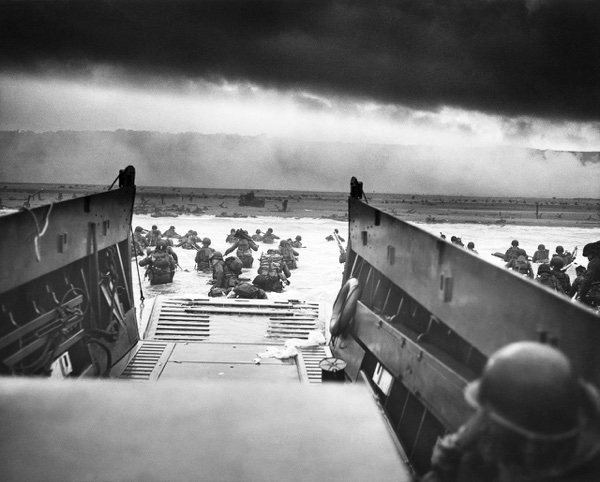“We cannot dedicate, we cannot consecrate, we cannot hallow this ground. The brave men, living and dead, who struggled here have consecrated it far above our poor power to add or detract.”
Abraham Lincoln enshrined these eloquent words into our minds and hearts when he dedicated the Gettysburg battlefield to history more than 150 years ago. The battle of Gettysburg turned the tide of the Civil War and the little Pennsylvania town became a symbol of courage, tragedy, and sacrifice.
On June 21 of this year, I had the privilege of standing on Omaha Beach, where another tide-turning battle took place 71 years ago, on June 6, 1944. The savage conflict, which lasted one day, was the beginning of the end of World War II in Europe.
The Germans predicted they would throw the allies back into the sea on that day. The Allies – French, British, Canadians, along with Americans – said they would clear the beaches and move inland to liberate France and ultimately, Europe. The allies were right, but it took almost 11 more months of difficult fighting before the guns were silenced.
My visit was part of an eight-day tour of Paris and Normandy on a Viking River Cruise. I didn’t come to these beaches to have fun or celebrate. I came to remember, and to somehow communicate a silent “thank you” for what so many men and women did in and around this beach when I was only seven years old.
We rightly build monuments to our military victories, defeats, and to those who fought and died in them. The American and French governments, together with organizations in many countries, have created two sharply contrasting monuments in Normandy that I was privileged to see and photograph. One is the American military cemetery above Omaha Beach, a beautiful, silent array of 9,300 crosses above the graves of American military personnel who died in Normandy in the summer of 1944. The other is a weird-looking collection of engineering relics on Juno Beach in the town of Arromanches, where Canadian troops fought a fierce battle against German defenders on D-Day.
The Cemetery remains world famous, partly because it was featured in the beginning and end of Steven Spielberg’s movie, Saving Private Ryan, in 1998. More than 2,000 American soldiers, sailors, and airmen died on and around Omaha Beach on D-Day and its immediate aftermath, mostly because Omaha was the most heavily defended area of Normandy by the Germans. We visited the graves of Robert and Frederick Niland, brothers who died on June 6 and 7. They provided the inspiration for Spielberg’s portrayal of the fictional Ryan family.
We also visited the grave of Theodore Roosevelt Jr., son of the 26th U.S. President, who is reportedly the only American general officer to land in the first wave of a battle with his troops. He was 56 years old and suffering from arthritis and a heart condition when he led the 4th Division troops ashore on Utah Beach. The young Roosevelt survived the Normandy battles, but died of natural causes 36 days later, on July 12. He never knew that he had been recommended to receive the Medal of Honor for his command exploits.
In stark contrast, there’s Juno Beach at Arromanches. It was on Juno that the Allies built one of two artificial harbors. Allied leaders knew they couldn’t capture Cherbourg or La Havre, two ready-made harbors in Normandy, until much later after D-Day. So they decided to build and install artificial harbors off the Normandy Beaches right after the initial conflicts were over. The one they installed on Juno provided the means for the Allies to get badly needed resources ashore to support the advancing troops pushing inland.
Engineers built huge concrete boxes and dropped them into the water to form a protective wall for the harbors and provide a base for steel roadways to take the supplies off the transport ships and transfer them to shore. Tanks, trucks, jeeps, food, medical supplies, ammunition, and even artillery pieces started coming ashore rapidly about 48 hours after the Juno Beach was cleared.

(Photo provided)
I spoke with a French citizen at Arromanches who was familiar with this unique construction work.
“The drivers that hauled those supplies had to drive carefully on the floating roads, and it was scary,” he said. “Sometimes, the vehicles were pitched off the artificial roads and fell into the water. But it mostly worked.”
A storm off Omaha Beach two weeks after D-Day destroyed that harbor, but this one off Juno, a few miles to the east, proved to be a successful supply base. Today, more than a dozen pieces of the harbor have been left in place. They are a memorial to the construction skills of the engineers and troops that built and operated this vital support function. It is a little known part of the D-Day story, but a vitally important one.
Our Viking ship took us to the magnificent gardens of Claude Monet, the French impressionist, and to the town where Joan of Arc, the 19-year-old middle-ages heroine, was imprisoned and executed. It took us to the Eiffel Tower, the unique eight-story steel structure that remains the tallest in Paris, and to the palace at Versailles, to view the famous Hall of Mirrors and see magnificent artwork on the ceilings and all over the walls. They were wonderful and informative visits.
But Omaha and Juno beaches were historical pilgrimages for me. They gave me an opportunity to appreciate again a generation that hallowed that sand forever.



